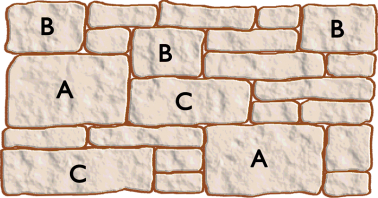Note: This document was adapted from an article by Bobby Watt, a well respected stone mason in Canada. Download the full article by Bobby Watt that was published in the Stone Foundation magazine.
Back in the days when stone buildings were structural as opposed to veneers, stone masons followed basic principles in order to build a structurally sound wall that could withstand the test of time. Although stone veneers are typically no longer structural, the most appealing walls are those which appear to be structural and stonework adheres to the traditional principles. Walls that display a higher level of stone craft are those where each stone has been set as if it were integral to the overall strength of the wall.
Try to lay sedimentary stones (limestones and sandstones) so their natural bedding planes (BP) are horizontal, not vertical with the natural cleft (NC) face exposed.

No stone should be laid taller than it is long, except at corners.

Avoid block or running joints only one stone on at least one side of a vertical joint.

Avoid setting more than three stones against a riser.

Risers should be evenly distributed throughout the wall. Grouping together of like-sized stones should be avoided.

Avoid using more than two stones of the same size on top of each other.

Unless by design, avoid the lining up of vertical joints in alternate courses.

Generally, risers should never touch except at corners and openings (jambs).

Don’t allow horizontal joints to run more than four or five feet. If possible, break up the horizontals on short stretches between windows and doors.

Try to provide a substantial bonding lap. A minimum of a quarter, and ideally a third, of the length of a stone being set should cross the joint between the stones below it.

